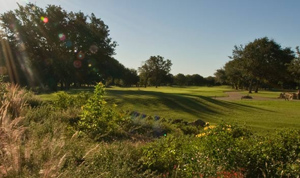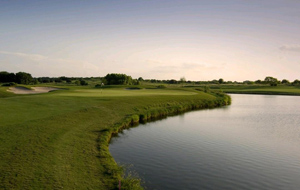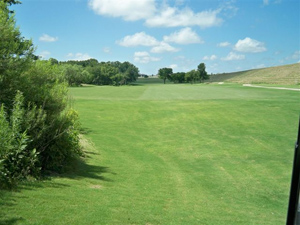Featured Golf News
Two Courses South of Austin Make the Grade
Austin, the hip and cool capital of Texas, was voted the best place to play golf a few years back mostly because of its selection of great daily-fee courses. Add in the wonderful private tracks in the city and those in the verdant Hill Country and you could literally tee it up every day for a month on a different course around here.

Grey Rock's 9th Hole
Two of the most-played courses in the city's southern confines and beyond illustrate the differing ways that Austinites enjoy golf and how the area is regarded for its fine layouts.
One such course, the Jay Morrish-designed Grey Rock Golf Club, has bucked the trend of private facilities changing to allow more access in these rough economic times. Instead, it changed from a public course to a semiprivate club, selling memberships when other clubs are struggling to retain their rank-and-file.
The other, the Roy Bechtol-fashioned Plum Creek Golf Club in the burgeoning Hays County suburb of Kyle, was recently given new life when the company that originally developed the community around the course reacquired it at a bankruptcy auction. The ownership change happened after Plum Creek welcomed more than 30,000 rounds in 2010, built a new clubhouse and cleared out areas around the course that had affected play for years, changes that made it too good of a facility and too valuable to let it fall by the wayside.
Besides their location south of Austin, the tie that binds this pair is Bechtol, the Austin-based golf course architect and master land-planner. Bechtol worked with Morrish on the routing of Grey Rock (then called Circle C Golf Club) in the early 1990s as he planned the neighborhood that would become one of Austin's most prestigious.
Bechtol and then-partner Randy Russell were contracted to design Plum Creek but were cut out of the final course by the owner, who paid off Bechtol and Russell and took the team's plan to build the course he wanted.
Both venues have been survivors and each has its own attributes. Recent rounds at Grey Rock and Plum Creek show that each has matured to test the best golfers while allowing high-handicappers a rocking good time. What else would you expect in Austin?

The Opening Hole at Grey Rock GC
Grey Rock's Subtle Appeals
Morrish did a fabulous job of routing Grey Rock through cedars and live oaks and the encroaching subdivision, with houses near the fairways on seven of the first nine holes. The site is mostly flat, but a series of ponds, well-placed bunkers and large rolling greens ringed by mounds and traps add spice.
The course encompasses 160 acres of the natural beauty found in Texas Hill Country. Grey Rock will not overwhelm you with length (it plays to a par of 72 and just 6,859 yards from its back set of four tees) or difficulty (rated 72.7 with a slope of 122 from the tips). What grabs you is variety, as the course sports two par-5s (the 509-yard second and 497-yard 17th) that can be reached in two, a pair of short par-3s (the 161-yard eighth and 168-yard 13th) that can be attacked, and two par-4s (317-yard ninth and 323-yard 15th) worth trying to drive.

Grey Rock's 10th Hole (Photo by Carlton Wade)
But the penalty for failing to pull off any of these feats is steep.
Grey Rock's best stretch of holes is found after the turn. The 406-yard 10th plays through a chute and uphill and to a long, narrow green whose back edge half-slopes away from the fairway. No. 11 (a converted par-5 at 459 yards) asks for two great shots to reach the oversized, plateaued putting surface, while the 431-yard 12th winds around a tree right of the landing area to an elevated green surrounded by mounds.
The home hole is only listed as the 12th hardest on the course at 386 yards from the tips, but water down the right edge and OB on the left in the shadow of the clubhouse make the closer a knee-knocker.

Grey Rock's Closing Hole (Photo by Carlton Wade)
Grey Rock GC is a fun track with a staff that pays strict attention to detail and bends over backwards to make sure your round here is enjoyable. With its Texas-style clubhouse and expansive practice area, Grey Rock is one of the top places to play in or around Austin. The course will celebrate its 20th year of golf in 2012.
For more information, visit http://www.thegolfclubatcirclec.com/page/101-2512.htm.
Plum Creek Best Course in Hays County
In the "old" days - like about 10 years ago - of the IH-35 corridor between Austin and San Marcos, if you found a hill and sat atop it for a while you could see for miles and spy little but prairie land and open spaces.
Those days have changed, as acres in south Travis County and northeastern Hays County are nothing short of a boom area. Right in the middle of one of the fastest-growing counties in Texas is Plum Creek, an excellent course that will test the nerves and savvy of the best players.
Plum Creek's original design belonged to Bechtol, but some of the architect's ideas for bunkering were a little too extreme for its former owners, and Bechtol abandoned the project before completing it. Still, the layout has a Bechtol feel and retains many of the natural long and rolling hills.

The Monstrous 2nd Hole at Plum Creek
The course features multiple water hazards, well-placed grass mounds and tightly guarded greens. Bechtol was able to accomplish all this in the par-72, 7,132-yard layout (a distance that merits a 74.0 rating and 125 slope) without any two abutting fairways.
For the most part, Plum Creek is wide open, but it's tight in all the right places. As the case on any course where trees are still growing, wind poses a considerable threat to your score here. Depending on the speed - which can gust up to 30 mph or more - and the direction, club selection becomes crucial.
There's no better example of the importance of judging wind speed and direction than on No. 2. When built, the par-5 was the fifth longest hole in the state, measuring in at a Texas-sized 659 yards from the tips. If the wind is in your face, six is a good score, so take your medicine here and move on.
As if one par-5 of more than 600 yards is not enough, the ninth - 605 yards from the back sets - will also test your resolve. With most of the hole uphill, solid contact all the way to the green is required for any chance at par.

The 10th Green at Plum Creek
The lone salve to the dual 600-yarders is that they play opposite each other across a large lake in the center of Plum Creek's 235 acres; if you have to play one against the wind, the breezes will assist on the other.
Even without the long par-5s on the front side, the inward nine can be tougher, as water comes into more play on Nos. 11, 13, 14 and 15. Among this quartet, the 14th - the No. 2 handicap hole even though it measures 382 yards from the tips - will make you think twice at the tee. Your drive must carry a lake the runs toward the green, meaning the further you hit closer toward the pin the farther your tee ball must carry.
If you're going to play driver here, watch out that you don't hit it too hard or you will knock it through the fairway turn. The optimal landing spot is guarded by a lonely bunker, and your second shot must cross a tributary running off the small pond before the green.
The 17th is another challenge. This 217-yard, par-3 plays to a slight-uphill green protected by two bunkers in front.
Plum Creek provides a good test, one that's even tougher if the wind is up - and it always blows across the hills above these Texas prairies.
For more information, visit http://www.plumcreekgolf.com/.
Steve Habel is one of Cybergolf's national correspondents, contributing news stories, features, equipment and book reviews and personality profiles from his base in Central Texas. He is also the managing editor for Texas CEO Magazine and works as a contributing editor for Horns Illustrated magazine, a publication focusing on University of Texas sports. He also writes a blog (www.shotoverthegreen.blogspot.com), which features news on golf and the Longhorns, and another (www.checkinginandplayingthrough.blogspot.com) on his many travels, which took him across the nation and to 105 different golf course in 2009. Habel is a member of the Golf Writers Association of America and the Texas Golf Writers Association.
Story Options
 |
Print this Story |
